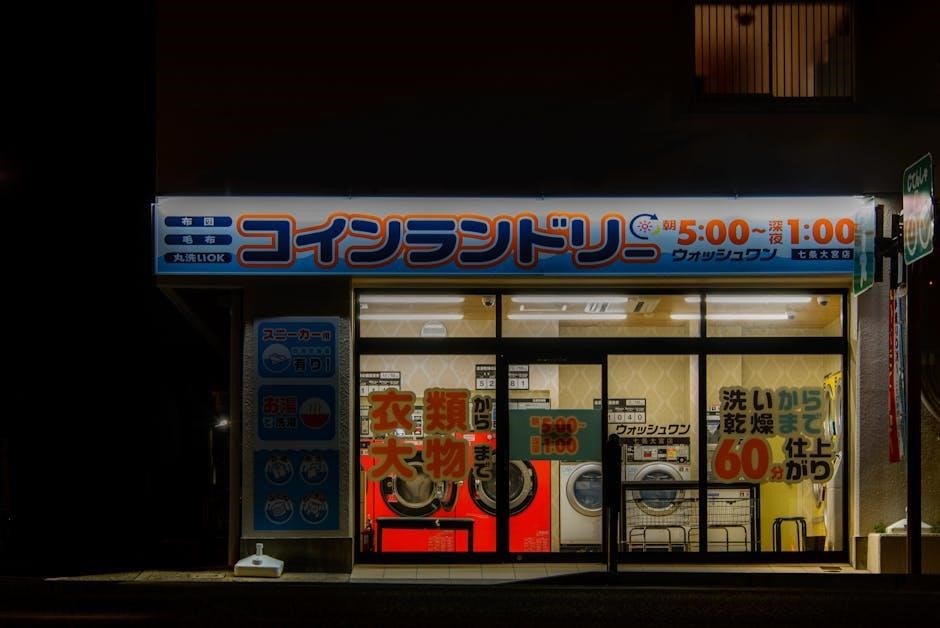Welcome to the Splendide Washer Dryer Combo Manual, your comprehensive guide to understanding and operating the WDC7100XC model. This manual provides detailed instructions for installation, operation, and maintenance, ensuring optimal performance and longevity of your appliance. Discover how to make the most of its advanced features, troubleshoot common issues, and access support when needed. Designed for both first-time users and experienced owners, this manual is essential for maximizing efficiency and convenience in your laundry routine.
Overview of the Splendide Washer Dryer Combo
The Splendide Washer Dryer Combo is a versatile, space-saving appliance designed for efficient laundry processing. Combining washing and drying functions in one unit, it offers convenience for small spaces like RVs or apartments. With front-loading design, multiple wash cycles, and energy-efficient operation, it simplifies laundry tasks. The WDC7100XC model features advanced controls, HE detergent compatibility, and optimal water usage, making it ideal for modern households seeking practicality and performance. Its compact size and robust functionality ensure it meets diverse user needs effectively.
Importance of Reading the Manual
Reading the Splendide Washer Dryer Combo Manual is essential for safe and effective use of your appliance. It provides critical information on installation, operation, and maintenance, ensuring you avoid common mistakes. The manual details safety precautions, optimal detergent usage, and troubleshooting tips to prevent errors and extend the appliance’s lifespan. Understanding the warranty terms and support options also helps you make informed decisions. By following the guidelines, you can maximize efficiency, prevent damage, and enjoy hassle-free laundry experiences. It’s a vital resource for both new and experienced users to get the most out of their unit.
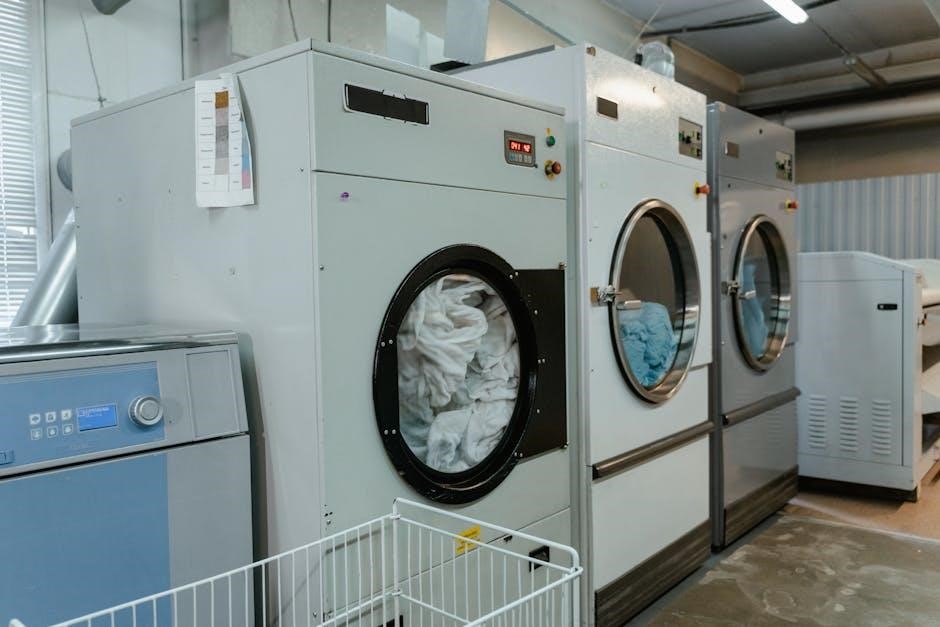
Installation and Setup
Proper installation is crucial for safe and efficient operation. Follow the manual’s step-by-step guide to unpack, remove transit screws, level, and install the washer-dryer correctly.
Unpacking the Washer Dryer
Begin by carefully removing the washer-dryer from its packaging. Inspect the appliance for any damage sustained during shipping and ensure all accessories are included. Gently lift the unit to avoid personal injury or further damage. Once unpacked, verify that all components, such as the power cord and installation hardware, are present. If any damage or missing parts are found, contact the retailer immediately. Proper unpacking ensures a smooth installation process and prevents potential issues during operation.
Removing Transit Screws
To prepare your washer-dryer for installation, remove the transit screws. Locate the back panel and take out the screws securing it. Lift the panel to access the transit brackets. Using the provided spanner, remove the fixing screws from the brackets on all four sides. Once the brackets are detached, ensure the appliance is stable and level. Proper removal of transit screws prevents damage during installation and ensures safe operation. Always refer to the manual for specific instructions tailored to your model, such as the WDC7100XC.
Leveling the Appliance
Proper leveling of your Splendide washer-dryer is essential to ensure stable operation and prevent vibration. Use the adjustable feet to align the appliance with the floor. Place a spirit level on top of the machine to check balance. Adjust the feet as needed until the appliance is perfectly level. Ensure the surface is firm and even to support the weight. Proper leveling prevents excessive noise and ensures optimal performance. Always verify the surface is level before finalizing the installation to avoid any operational issues.
Installing the Washer Dryer
After leveling, secure the washer-dryer in its designated space. Connect the water supply lines to the rear ports, ensuring they are tightly fitted to avoid leaks. If vented, attach the venting system according to the manual’s instructions. Plug the appliance into a grounded electrical outlet. Use the provided installation kit or purchase one from Splendide for specific needs. Double-check all connections for stability and proper alignment. Ensure the surface is strong and level to support the appliance’s weight. Refer to the manual for detailed installation steps to ensure a safe and proper setup.

Operating Instructions
Operate your Splendide Washer Dryer Combo with ease by following the control panel guide. Select wash and dry cycles, adjust settings, and monitor progress. Always use HE detergent, optimal load sizes, and ensure proper water pressure for best results. Refer to the Wash Cycle Table and Dry Cycle Options for detailed settings. Regularly clean filters and maintain the appliance to ensure efficient performance and longevity. Troubleshoot common issues using the provided chart or contact support if needed.
Control Panel Overview
The Splendide Washer Dryer Combo features an intuitive control panel designed for easy operation. The panel includes buttons for selecting wash and dry cycles, adjusting temperature, and enabling special functions like delicate or bulky loads. A clear digital display shows the selected settings and cycle progress. Use the dial or buttons to navigate through options, ensuring precise control over your laundry process. The control panel also alerts you to errors or maintenance needs, guiding you to resolve issues quickly. Refer to the Wash Cycle Table and Dry Cycle Options sections for detailed cycle descriptions and settings.
Wash Cycle Table
The Wash Cycle Table in the Splendide Washer Dryer Combo Manual outlines the various wash options available, including normal, delicate, bulky, quick wash, and heavy-duty cycles. Each cycle is designed for specific fabric types and soil levels, ensuring optimal cleaning. Temperature settings range from cold to hot, catering to different laundry needs. The table also highlights special features like pre-wash, rinse-and-spin, and eco-mode. Refer to this table to select the most suitable cycle for your load, ensuring efficient and gentle cleaning of your garments. Proper cycle selection enhances fabric care and machine performance;
Dry Cycle Options
The Splendide Washer Dryer Combo offers a variety of dry cycle options to suit different fabric types and drying needs. Choose from options like delicate, normal, bulky, and quick dry cycles. The appliance also features advanced temperature settings, including low, medium, and high heat, as well as an air-dry option for sensitive fabrics. Special features include a moisture-sensing system that automatically adjusts drying time and a vented drying option for efficient moisture removal. These options ensure your clothes are dried gently and thoroughly, preserving fabric quality and reducing wrinkles. Proper cycle selection enhances drying efficiency and fabric care.
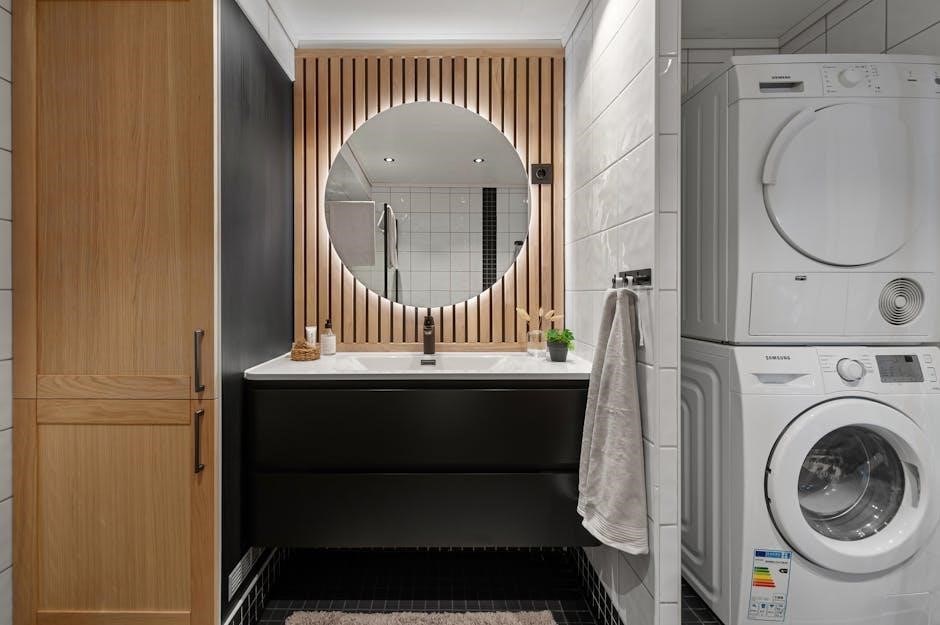
Best Practices for Usage
Always use HE detergent for optimal performance. Ensure optimal load sizes to prevent damage and maintain efficiency. Check water pressure recommendations to avoid operational issues. Regular maintenance and proper usage extend the appliance’s lifespan and ensure reliable operation. Consult the manual for specific guidelines to achieve the best results from your Splendide Washer Dryer Combo.
Using HE Detergent
Using HE detergent is essential for optimal performance of your Splendide Washer Dryer Combo. HE detergents produce fewer suds, reducing the risk of clogging and improving drainage. Use the recommended amount to avoid residue buildup and maintain efficiency. Excess detergent can lead to poor wash results and increased maintenance. Always follow the guidelines in the manual for proper dosage. This ensures cleaner clothes, better appliance performance, and a longer lifespan for your washer-dryer combo. Proper detergent usage is key to achieving the best results in every cycle.
Optimal Load Sizes
Optimal load sizes are crucial for efficient performance of your Splendide Washer Dryer Combo. Avoid overloading, as this can lead to poor cleaning results and increased wrinkling. Clothes need space to move freely for proper washing and drying. Aim for a load size that fills the drum to 2/3 to 3/4 of its capacity. Separate delicate items from bulkier fabrics to ensure even cleaning and prevent damage. Proper load sizing enhances cleaning efficiency, reduces wear on the appliance, and helps maintain energy efficiency for optimal results.

Water Pressure Recommendations
Proper water pressure is essential for the efficient operation of your Splendide Washer Dryer Combo. The recommended water pressure range is between 10 PSI and 120 PSI. Ensure the water supply lines are fully opened and free from obstructions. If your water supply pressure is too high or low, consider installing a water pressure regulator to stabilize the flow. This helps maintain optimal performance, prevents damage to the appliance, and ensures consistent cleaning and rinsing results. Always check and adjust the water pressure settings as needed for your specific setup.

Care and Maintenance
Regularly clean the appliance and check filters to ensure optimal performance. Refer to the manual for detailed maintenance instructions to prolong the life of your washer-dryer combo.
Cleaning the Appliance
Regular cleaning is essential to maintain your Splendide washer-dryer combo’s performance. Remove debris from the gasket and detergent dispenser after each use. Run a cleaning cycle monthly using a washer cleaner or vinegar to eliminate odors and residue. Check and clean the drain pump filter regularly to ensure proper water flow. For tougher stains, mix baking soda and water for a natural cleaning solution. Always refer to the manual for specific cleaning recommendations to keep your appliance in top condition and prevent maintenance issues.
Drain and Filter Maintenance
Regular drain and filter maintenance ensures smooth operation and prevents issues. Check the drain pump filter monthly to remove lint and debris. Locate the filter at the bottom of the washer-dryer, turn off power, and rinse it thoroughly. Ensure the drain hose is securely connected and not kinked. For optimal performance, clean the filter after every 30 cycles. Proper maintenance prevents clogs and odors. Refer to the manual for specific guidance on accessing and cleaning these components effectively.
Regular Servicing Tips
Regular servicing is crucial to maintain the performance and longevity of your Splendide washer-dryer. Check and replace worn-out parts like door seals and gaskets annually. Ensure the venting system is clear and functioning properly to avoid moisture buildup. Every 6 months, run a cleaning cycle with a washer cleaner to remove detergent residue. Schedule professional servicing once a year to inspect internal components. Always refer to the manual for specific servicing recommendations and contact Splendide support if you notice unusual wear or performance issues.
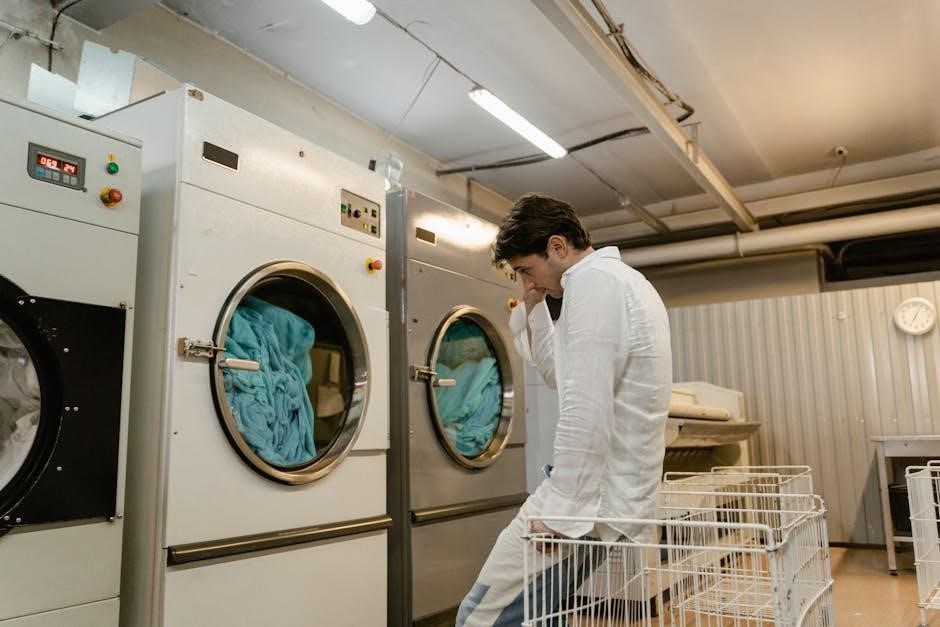
Troubleshooting Common Issues
For the Splendide WDC7100XC, common issues include error codes, poor washing performance, or drying inefficiency. Always check the troubleshooting chart in the manual for solutions. Verify water pressure, ensure the vent is clear, and clean filters regularly. If issues persist, contact Splendide support for assistance. Regular maintenance and proper usage can prevent many problems, ensuring optimal performance.
Troubleshooting Chart
The Splendide Washer Dryer Combo Manual includes a detailed troubleshooting chart to help diagnose and resolve common issues. Refer to this chart for error codes, such as E1, E2, or E3, which indicate problems like low water pressure or obstruction in the vent. Each error code is paired with a solution, such as checking water supply lines or cleaning the filter. Additionally, the chart addresses issues like poor washing or drying performance, offering steps to ensure proper detergent usage and vent clarity; Regularly reviewing this chart can help prevent and quickly fix problems, ensuring efficient appliance operation.
Resolving Common Errors
The Splendide Washer Dryer Combo Manual provides practical solutions for addressing common errors. Issues like poor washing performance or excessive wrinkling can often be resolved by adjusting load sizes or ensuring proper detergent usage. If error codes appear, such as E1 (low water pressure) or E3 (vent obstruction), refer to the troubleshooting chart for step-by-step fixes. Regularly cleaning the filter and checking the vent system can prevent many issues. For persistent problems, contact Splendide Support for assistance, ensuring your appliance runs efficiently and effectively. Always follow the manual’s guidelines for optimal results.
When to Contact Support
Contact Splendide Support if you encounter issues beyond basic troubleshooting. Reach out for complex errors, persistent problems, or if the appliance is damaged during unpacking. Call 1-800-356-0766 or email splendide for professional assistance. Ensure you have your model number and a detailed description of the issue ready for faster resolution. Support is available to address warranty claims, repair needs, and technical queries, ensuring your washer-dryer operates efficiently and effectively.
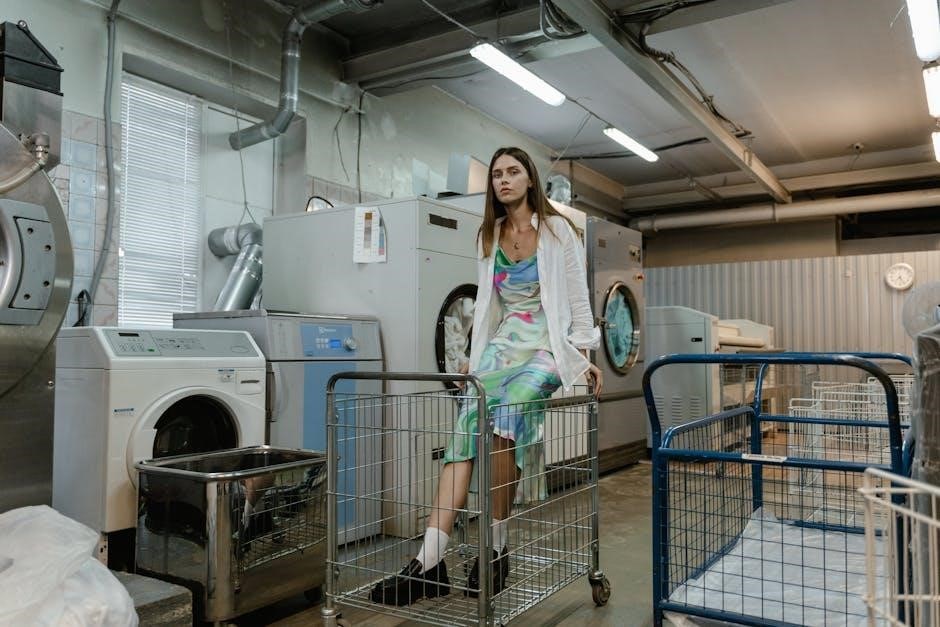
FAQs and Sample Loads
Find answers to common questions about the Splendide Washer Dryer Combo and discover optimal load sizes for efficient washing and drying. Ensure best results with HE detergent.
Frequently Asked Questions
Common queries about the Splendide Washer Dryer Combo include optimal detergent usage, load size recommendations, and troubleshooting tips. Users often ask about HE detergent requirements, ensuring efficient cleaning without exceeding capacity. Another frequent question is how to resolve common errors, such as improper water pressure or lint buildup. Additionally, many inquire about maintenance routines, like cleaning filters and drains, to maintain performance. For detailed answers, refer to the troubleshooting chart and product guidelines provided in the manual for optimal appliance care and operation.
Sample Load Guidelines
For optimal performance, the Splendide Washer Dryer Combo recommends balancing loads according to fabric type and weight. A typical load includes 3-4 lightweight items like shirts or towels. For bulkier items, such as jeans or bedding, reduce the load size to 2-3 pieces. Delicates should be washed separately in smaller quantities. Always use HE detergent and avoid overloading to ensure efficient cleaning and drying. Check fabric labels for specific care instructions to prevent damage and maintain appliance efficiency.

Warranty and Support
Every Splendide washer-dryer comes with a Limited Warranty; Read the warranty statement for complete details. Contact Splendide Support at 1-800-356-0766 or email splendide@westlandsales.com for assistance with any inquiries.
Understanding the Limited Warranty
Your Splendide washer-dryer combo is protected by a Limited Warranty, which covers defects in materials and workmanship for a specified period. This warranty is non-transferable and applies only to the original purchaser. It does not cover damage caused by misuse, neglect, or improper installation. For complete details, refer to the warranty statement provided with your appliance. Contact Splendide Support for any questions or concerns about your warranty coverage.
Contacting Splendide Support
For assistance with your Splendide washer-dryer combo, contact their support team at 1-800-356-0766 or via email at splendide@westlandsales.com. Visit their website for additional resources, including manuals and troubleshooting guides. Splendide’s office is located at 15650 SE 102nd Ave, Clackamas, OR 97015. Ensure you have your model number and a detailed description of your issue ready when reaching out. Their team is available to address warranty claims, repair needs, and general inquiries to help you maintain your appliance effectively.
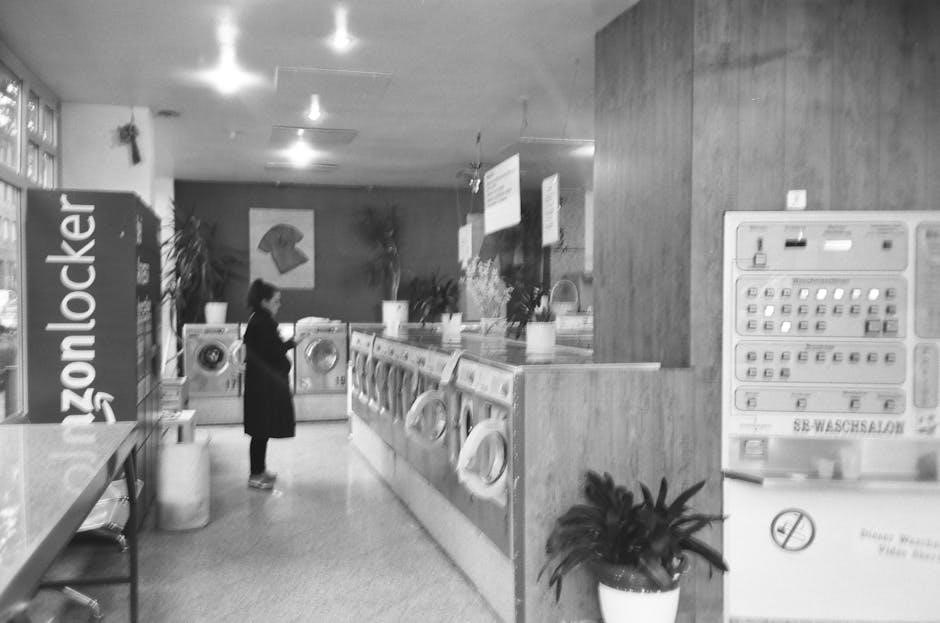
Additional Resources
Download the Splendide Washer Dryer Combo Manual from the official website or access AI-powered Q&A support for instant answers. Visit splendide.com for guides, FAQs, and troubleshooting tools.
Downloading the Manual
To access the Splendide Washer Dryer Combo Manual, visit the official Splendide website. Navigate to the support section and enter your model number (e.g., WDC7100XC) to download the PDF. Ensure you select the correct version for your appliance. The manual is also available through AI-powered Q&A platforms, offering instant answers and troubleshooting guides. For convenience, save the manual to your device for quick reference. This ensures you always have access to operating instructions, care tips, and warranty details whenever needed.
Online Support and Guides
For additional assistance, Splendide offers extensive online support and resources. Visit their official website to access FAQs, troubleshooting guides, and detailed user manuals. AI-powered Q&A platforms provide instant answers for common queries. Video tutorials and interactive guides are also available to help you understand your appliance better. Furthermore, online forums and communities allow you to connect with other users and share tips. For technical issues, contact Splendide support directly via phone or email for personalized assistance. These resources ensure you can resolve issues and optimize your washer-dryer’s performance effortlessly.
Final Tips for Optimal Use
For the best experience with your Splendide Washer Dryer Combo, always use HE detergent, avoid overloading, and ensure proper ventilation. Regularly clean filters and check water pressure to maintain performance. Refer to the manual for troubleshooting common issues and schedule annual servicing. By following these tips, you’ll extend the appliance’s lifespan and enjoy efficient, worry-free laundry cycles. Happy washing!
